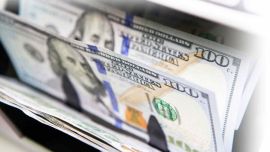Alberto Fernández’s government is entering its final hours. The man who took power after winning the 2019 election against Mauricio Macri said goodbye to the Casa Rosada on Wednesday and spent his last working day there on Thursday, before he hands over the presidential sash to Javier Milei in Congress on Sunday.
The Peronist leader has been rocked by currency turmoil during his four years in office and the unofficial, parallel “blue dollar" rate stood at 995 pesos for buying and 945 pesos for selling on Wednesday – just shy of breaking into four digits, a turn of events seen often over the last few months.
Underlining the huge gap between the 'blue' and the 'official' rate, the latter stoofd at 382 pesos and 362 pesos respectively, with a 161-percent gap between them.
Over the last four years, the US currency has been under permanent discussion, a constant part of public economic debate. It is worth noting that, although the dollar is not in people’s wallets or bags every day, it is the currency used to trade internationally, which sets reference parameters for goods, such as smartphones, services, such as streaming, raw materials, such as oil, soy and wheat, among others, which can have an impact on price rises, and by extension, inflation rates.
On December 10, 2019, when Fernández was inaugurated, the rate stood at 63 pesos, after a 540-percent devaluation during the Juntos por el Cambio administration, whereas the parallel “blue” rate could be found at 69.50 pesos, after a 379.3-percent rise over the four years between 2015 and 2019.
According to figures from the Libertad y Progreso Foundation, over the past eight years of government (December 9, 2015 to December 7, 2023), taking in the Mauricio Macri and Alberto Fernández presidencies, the official exchange rate has soared 506 percent while the 'blue dollar' has risen 1,331 percent.
In Congress, Alberto Fernández himself has stressed that the constant currency turbulence has been one of the causes behind Argentina's economic “free-fall.”
“In his inauguration address, it was clear that he wanted to help people. However, with all the determining factors we can add, such as the [Covid-19] pandemic, he leaves behind a government with completely out of control variables,” stated economist Gastón Lentini.
Two of his campaign promises were specifically related to these topics: the quest for a “competitive dollar” (something that did not happen if we compare the weight of the legal tender as against other countries in the region) and the accumulation of Central Bank reserves, another missed target.
Hours after the Fernández-Fernández ticket was inaugurated, the Central Bank’s international reserves stood at US$43.785 billion. Even though there were periods in which they rose, with an upper ceiling of US$46.3 billion in August 2021, during the administration there has always been a downward trend. The Central Bank currently has US$21.329 billion in international reserves – the lowest value since March 2006.
This can be explained, among other reasons, not only by the macroeconomic imbalances caused by the different measures taken, but also by the debt commitments with the International Monetary Fund, with whom Argentina has a US$44.5-billion credit programme.
According to the chief researcher of the Ecolatina consultancy firm, Santiago Manoukian, the government’s actions in this aspect have been “extremely poor.”
“In 2021 certain inconsistencies started to be noticed and there were corrections which were not carried out, when the world showed favourable conditions. In 2022, we had a crisis of the debt in pesos and the multiple exchange rates started, with the first 'soy dollar' [scheme]. And [former economy minister] Martín Guzmán’s resignation caused an overshooting of the dollar. That’s where the figure of [current Economy Minister] Sergio Massa showed up,” he told Perfil.
The economist also pointed to “the foreign exchange delay” and the gap between the official rate and the financial and parallel rates. He also trained criticism on the SIRA import system, which he considered “stepped on imports,” with a record debt for the Central Bank which today stands at US$58.5 billion – a “bomb” which is part of the legacy to be received by incoming president Javier Milei.
Market analyst Elena Alonso agreed, and highlighted that “the administration has not been very favourable.” The impact of the measures taken over the last four years “will be felt later on,” during the libertarian’s imminent administration, she added.
“Foreign exchange restrictions ended up doing harm. On the one hand, we need to protect local industry when conditions are adverse and the dollar is in very high demand, but some serious distortions have been generated which make them not beneficial. For a few months now industrial businesses have not been able to import supplies. The measures were inconsistent and were not enough,” she added. Looking ahead, according to Manoukian “the situation is very delicate.”
Rumours are already circulating about a potential devaluation of the peso once Milei takes office. Libertarian City mayoral candidate Ramiro Marra’s stockbroker company, Bull Market Brokers recently reported that it could be as much as 100 percent.
According to the agency, “the market beings to operate with a leap to 640-650 pesos” and a second foreign exchange increase in February, around 1,000 pesos, with a view to finalising one of Milei’s main economic proposals: dollarisation.




















Comments